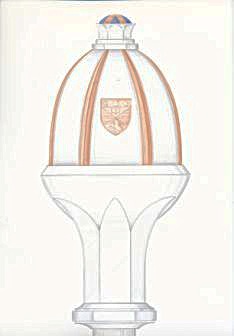600th Anniversary Papal Mace

The latest addition to a collection of maces dating back to medieval times is to play a key role in the forthcoming St Andrew’s day graduation ceremony at the University of St Andrews this week (Monday December 1, 2014).
The silver and gold mace, which will be known as the 600th Mace, will be carried at the ceremony: alongside the University’s original 15th century maces – the St Salvator’s Mace (1461), the Arts Mace (1416) and the Canon Law Mace (c. 1450). The medieval faculty and college maces have been carried in ceremonies in St Andrews for over half a millennium, representing the authority of the University.
Last century these were augmented by the more recent additions of the Mace of the School of Medicine (1949) and the University Mace (1958).
The 600th mace, which will be formally referred to as the Six Centuries Mace, is a gift from the Roman Catholic Church to mark the 600th anniversary of the founding of the University. It has been crafted in the workshop of the Edinburgh silversmiths Hamilton & Inches who also made the mace of the Faculty of Medicine.
Andrew Teden of Hamilton & Inches said:
“We were honoured to be invited once again to create a Mace for St Andrews University, 64 years since the Mace of the Faculty of Medicine was crafted in our silver workshops. Our workshop manager Jon Hunt took great care to ensure that the concept was genuinely worthy of a piece with such a historical significance as The 600th University Mace.”
The mace will carry an inscription indicating that it was presented in the Pontificate of Pope Francis, who also sent a greeting to the University at the culmination of the 600th celebrations which said:
“His Holiness invokes upon all the staff and students of the University, past and present, the abundant blessings of Almighty God, as a pledge of heavenly peace and joy”.
The designer is Jon Hunt, master silversmith, who worked in conjunction with Professor John Haldane of St Andrews University, a Consultor to the Vatican’s Pontifical Council for Culture.

Professor Haldane said:
“This completes a triple recognition of the University St Andrews. During his visit to Scotland at the outset of this decade Pope Benedict referred to the university beginning to mark the 600th anniversary of its foundation, then last year Pope Francis sent a message of congratulation and now his office has granted permission for the inclusion of his coat of arms on the head of a mace commissioned to mark the completion of several centuries and the beginning of who knows how many more”
The mace is in sterling silver with rose gold details. It has an enamel and gold St Andrews Cross motif to the top of the head and also carries the arms of the University and those of Pope Francis, chased and engraved in gold. The overall length of the mace is 1100mm with a central tube diameter of 38mm. The lower section of the shaft carries the inscription:

“From the Scottish Catholic Church in the Pontificate of Pope Francis to the University of St Andrews in celebration of its six centuries. St Andrews Day 2014”.
The head of the 600th mace is reminiscent of the distinctive profile of Brunelleschi’s famous 15th century dome for the Cathedral of Florence, and also of the form of an acorn recalling the fact that the University grew from a seed sown by the medieval Church, and also expressing confidence that
further strong centuries-long growth lie ahead. The overall design has a contemporary simplicity reflecting the unaffected demeanour encouraged and exemplified by Pope Francis.

NOTES TO NEWS EDITORS
Images of the designs for the 600th anniversary mace are available from the Press Office. Contact 01334 462 108.
Three graduation ceremonies will be held on Monday December 1; at 0930 hours, 1215 hours, and 1530 hours. Media are welcome to attend. Please notify the Press Office in advance on 01334 462 108.
Founded in the 15th century, St Andrews is Scotland’s first university and the third oldest in the English speaking world. Teaching began in the community of St Andrews on the east coast of Scotland in 1410 and the University was formally constituted by the issue of Papal Bull in 1413.
Category University news